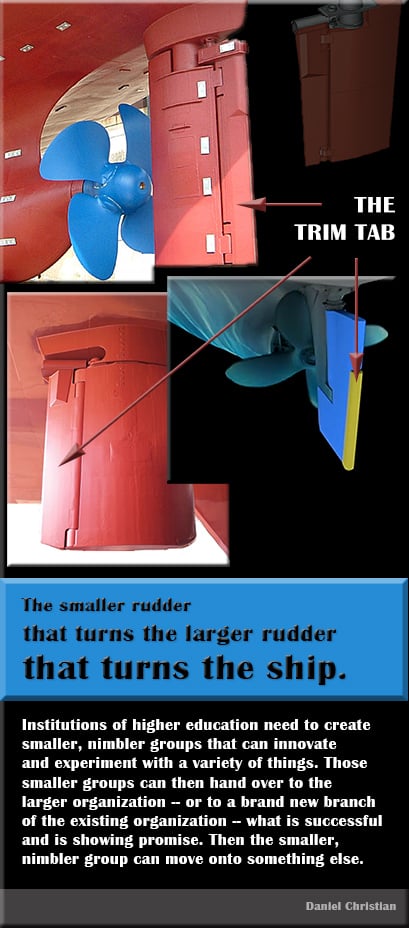Published on
The Need For More “Trim Tab Groups” In Higher Education

I don’t remember exactly where I was or when it was that I first read about the explanation for the term “Trim Tab Group,” but the concept instantly resonated with me. It resonated with me because I’ve worked for large organizations throughout my career. In fact, even now as I work in the higher education space, the term still resonates with me.
Backing up a step, you might ask, “What’s a trim tab?”
For the sake of this article, I’m going to be using a very large ship to answer that question. For those of you who are engineers or highly technical, please bear with me as I may be missing pieces of a fuller explanation. However, the definition that I’m going to use will hopefully serve to relay and illustrate my main point.
If you were to be able to see a large ship completely out of water, and you walked back to the end of the ship – to the part that has the enormous apparatus that helps to steer the ship – you would see a large rudder. On that large rudder is a smaller rudder, called a trim tab. The trim tab, in effect, is the smaller rudder that turns the larger rudder that then turns the ship.
So to apply this concept to the world of higher education: what higher education institutions need to develop these days are those smaller, nimbler groups that can innovate and experiment with a variety of things. Those smaller groups can then hand over to the larger organization—or to a brand new branch of the existing organization—what is successful and is showing promise. Then the smaller, nimbler group can move onto something else.
This perspective is helpful because higher education—as an industry—is increasingly under pressure to innovate, to change, to adapt in order to:
- Demonstrate a solid return on investment to students and to their families
- Help students build the foundations that they need to launch and sustain successful careers in a world that is quickly and constantly changing (e.g., think automation, artificial intelligence, robotics, algorithms and the like)
- Provide services throughout a person’s lifetime—and not just for 4 to 6 years after a student graduates from high school
- Respond to a decreasing or flat level of state-sponsored/legislated financial support
- And address many other pressures currently being experienced by many segments of the field
By forming Trim Tab Groups throughout higher education, we gain the capacity to experiment with relatively small projects that will ultimately have much larger impacts on the institutions and the learners that those institutions serve. The tricky things here are that:
- What might work well at one institution might not work so well at another institution
- The culture of the institution has to be able to support such experimentation and be ok with some projects/endeavors that don’t pan out (i.e., some level of failure is to be expected here)
- How best to hand the batons off from the smaller group to the larger organization (or to a new branch) and then move onto something else
This is not a moot issue. We need to work on this! For the vast majority of institutions out there, we need to become more innovative because many people are being forced to consider less expensive alternatives (note the rise of bootcamps, MOOCs, certificates or degrees from less expensive sponsored partnerships, and the like). It’s well known and documented that the price to obtain a college degree has continued to rise throughout the last several decades. Yet the college degree is still often a portal to a successful career that can then support a person (as well as their loved ones). As such, many segments of higher education must adapt and change—or risk servicing far fewer learners over the next two to three decades, as they watch their customers head elsewhere. And then it’s a costly game of musical chairs for faculty and staff, as the larger organizations downsize.
What’s more, for me, this has now become a social justice issue. If the college degree is to continue to be the portal to a successful career, then it must move towards becoming more inclusive and accessible. Unfortunately, along the current trajectory higher education is becoming more exclusive and often less obtainable for many members of our society.
Author Perspective: Educator




